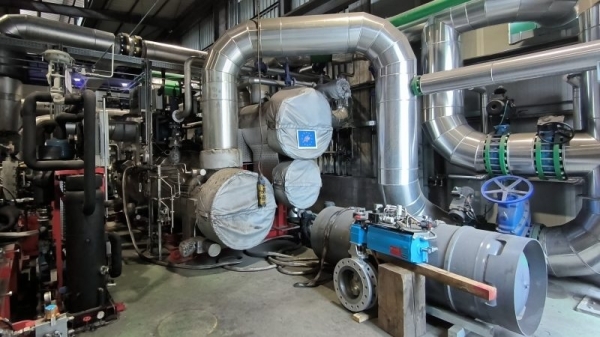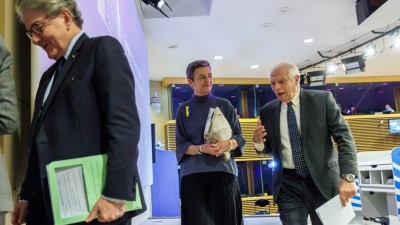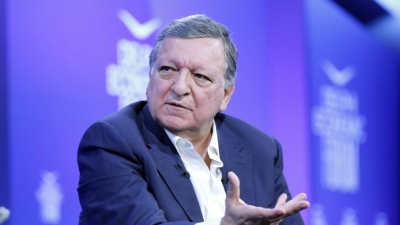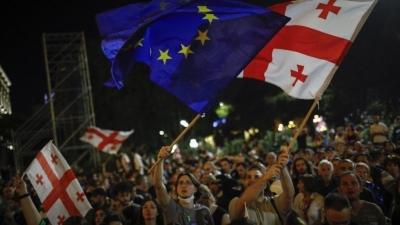Large electrical heat pumps can be key to decarbonising Europe’s industry

Though the EU has focused much of its industrial decarbonisation drive on the production and use of hydrogen, in a factory west of Milan, Italy, a quiet revolution is underway – the electrification of lower-temperature heat.
Industrial heat demand is one of the largest individual drivers of energy consumption, a large chunk of this demand is for temperatures below 200°C, accounting for 37% of industrial demand in Germany, according to a study by the Berlin-based think-tank Agora Energiewende.
Large heat pumps are at the forefront of efforts to decarbonise this heat demand. Like heat pumps for houses or apartments, these machines use electricity to multiply ambient heat in the air, ground, or water. But unlike domestic versions, they are hundreds of times more powerful, cost millions of euros, and can cheaply produce temperatures of up to 200 °C – if provided with the right heat source.
Sub-200°C industrial heat is typically used to produce steam, as used in the chemical industry, or for drying process in paper manufacture.
Italian supplier Turboden is installing a 12 MW heat pump for a pulp and paper producer in Finland, whose job is to take 100 °C heat from factory exhaust and boost it to a scalding 170 °C.
Large potential, immediate challenges
Up to now, Brussels has focused much of its industrial decarbonisation drive on the production and use of hydrogen, a clean-burning gas. This technology is much more suited to produce higher temperatures – the other 63% of industrial heat demand.
Unfortunately, industrial and domestic heat pumps have not received the same attention – a previously announced action plan was taken off the commission’s agenda in December of last year.
“It is still economically difficult for large heat pumps,” says leading expert Jan Rosenow, head of the clean energy think-tank, Regulatory Assistance Project (RAP), in Europe, attributing their lack of success to two factors: “Low gas prices and high capital costs.”
While large heat pumps can be cheaper to operate than generating heat from fossil fuels, upfront investment costs tend to be higher.
But Andrea Magalini, Turboden’s general manager for its heat business unit, remains optimistic.
Speaking to journalists at the company’s headquarters in Brecia, Italy, Magalini foresees “bright developments for the heat pump market in the next decade.”
The global market for large heat pumps could grow 15% per annum to $40 billion by 2030, he added.
Insiders point to the European energy crisis, and growing pressure to decarbonise, as the reason for the sudden – by industry timelines – surge in demand for large heat pumps. Turboden’s Finnish customer is hoping to slash its dependence on Russian gas.
Turboden looks to capture a small share of this market: by 2026, the company wants to grow its sales from €120 million a year to €200 million, according to CEO Paolo Bertuzzi – mostly on the back of selling more heat pumps, which the company began offering only in 2019.
Increasingly, the company is being outpaced by market demand. “Our customers are asking us for solutions, but we haven’t had time to test,” he says.
Magalini is however more bullish than his boss, stressing the market will be huge. He is already planning annual sales of ten large heat pumps, each with a minimum capacity of 5 MW – most of which are finely tuned to customer specifications.
Other European players are happy to capture their share of this growing market: German titans, Siemens Energy, and Maschinenfabrik Augsburg-Nürnberg (MAN) are leading the charge. Siemens recently struck a deal with Heineken to supply 15 large heat pumps for its breweries by 2025.
Three sectors driving demand
Alongside industrial processes two other key sectors are driving interest in decarbonised heat, says Bertuzzi.
First, there is centralised heating for residential districts. MAN is constructing a massive 50 MW project, to provide heating for 25,000 homes in the Danish town of Esbjerg. The project will use seawater as a local heat source, boosting temperatures before pumping the hot water into homes.
Second, there is carbon capture requiring green heat. Carbon capture projects have yet to be realised at scale, but will eventually see heat pumps produce the steam necessary to prime critical chemicals.
An ambitious sector
“I don’t know if the kick-off of the large heat pump market is 2024, but the tenders are certainly there,” says Turboden’s CEO, adding that utilities were the current top clients, having the ability to spend cash from the European recovery fund.
What was once a niche interest, is now becoming a mainstream business. Industry trade shows, like the Copenhagen High-Temperature Heat Pump Symposium, have seen attendance increase by 400% in recent years.
More opportunities are flooding in too. A new ‘Carbon Contracts for Difference’ auction launched by the German government earlier this month will see €4 billion awarded to industrial companies hoping to decarbonise, followed by €19 billion in a second round in Autumn.
Paper companies and the chemical industry could do well in these auctions – they account for much of German demand for low-temperature industrial heat.
While headwinds remain, the future looks promising for large heat pumps.
Read more with Euractiv




